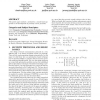1490 search results - page 114 / 298 » The Logic of Authentication Protocols |
GECCO
2006
Springer
14 years 19 days ago
2006
Springer
This poster paper outlines a method for a search based approach to the development of provably correct protocols. Categories and Subject Descriptors C.2.2 [Computer Communication ...
IWCMC
2006
ACM
14 years 2 months ago
2006
ACM
The DNS Security Extensions (DNSSEC) were developed to add origin authentication and integrity. DNSSEC defined a public key infrastructure over DNS tree hierarchy for the public ...
ISW
2005
Springer
14 years 2 months ago
2005
Springer
We present a fully symmetric constant round authenticated group key agreement protocol in dynamic scenario. Our proposed scheme achieves forward secrecy and is provably secure und...
ACNS
2009
Springer
14 years 3 months ago
2009
Springer
Abstract. We examine the problem of message recognition by reviewing the definitions and the security model in the literature. In particular, we examine the Jane Doe protocol, whi...
SP
1998
IEEE
14 years 1 months ago
1998
IEEE
A strand is a sequence of events; it represents either the execution of legitimate party in a security protocol or else a sequence of actions by a penetrator. A strand space is a ...

